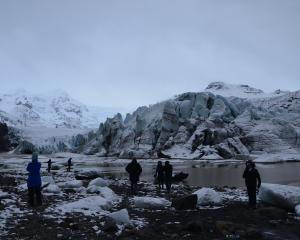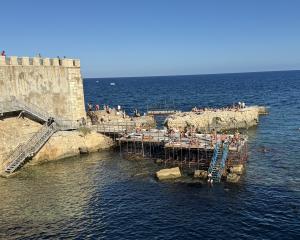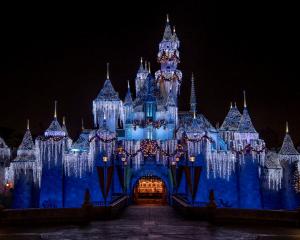In the first of a two-part Western Australian adventure, Pam Jones catches a millennia-old wave in the wheatbelt of Western Australia and finds a region full of quirks and beauty.
It was 15m tall and 110m long and looked for all the world as if it would crash down on the people underneath in a swirling, heaving mass.
But the statuesque wave was a thrill of a different kind, instead carved out of rock to provide one of many wonders and surprises during a trip across the wheatbelt region of Western Australia.
Wave Rock is one of the most popular attractions in the much-visited wheatbelt region, attracting more than 110,000 visitors a year who climb, photograph and marvel at the giant striped rock created over millennia by water coaxing away the softer rock around it and leaving a large, wave-like granite monument behind.
Taking a guided tour around the area is a good idea as you will hear little-known stories about the rock from the wonderful Sheenagh Collins, practically the custodian of the Wave Rock region because of her family's history developing and caretaking the area around it and her determination to make sure future plans are appropriate.
But you can also wander around and clamber over Wave Rock by yourself, as well as venturing slightly further afield to visit other nearby landmark rocks and trails which collectively make up the massive outcrop of Hyden Rock: Hippo's Yawn, the Breakers, King Rocks and the Humps, which contain Mulka's Cave, full of hundreds of ancient handprint-type Aboriginal paintings.
It was a much-appreciated, native bush and Australian history-filled stop along the charming wheatbelt region, which extends east from Perth and is split into several different areas.
We were exploring the central wheatbelt and had stopped first in York, a small and pretty town just over an hour from Perth and perfect for a day exploring its historic buildings or excellent motor museum, or spending the night listening to kookaburras in the friendly camping ground.
From there we drove alongside a patchwork of colour, marvelling at vast fields of wheat and canola, the landscape alternating between frog-green and bright yellow as the crops varied, the setting sun then bringing wildlife to the fore; watch out for kangaroos, which are great attractions for visitors but can cause havoc on roads at sunrise and sunset.
Check with the locals about the safest times to drive.
But we were nonetheless thrilled when we chanced upon numerous roos from a safe distance, as well as a dingo, a family of emus and areas of wonderful hardy wildflowers.
Western Australia is well known for its wildflower season, which extends from July to November and peaks at different times in different areas.
Again, do some research before deciding what time of year to travel and which regions to visit.
There are some areas where you can find whole fields of wildflowers, but taking a guided tour or at the very least seeking local advice can be a good idea if this is what you want to see.
Instead, what we saw were endless, changing patches of wildflowers sprinkled along roadsides, which kept throwing up more attractions and reasons to pause and reflect.
Part of the Pathways to Wave Rock Drive Trail is the Tin Horse Highway near Kulin, an area of obvious ingenuity as what started as a marketing campaign for the district's famous annual Kulin Bush Races has ended up being a permanent attraction.
Bright, quirky ''tin horse'' creations line two roads surrounding the town, forming an outdoor gallery of sorts.
Before that is another monument to rural values, the Corrigin Dog Cemetery.
Visiting this is both a heart-warming and tear-in-the-corner-of-your-eye experience, as short but tender tributes mark the final resting place of many of man's best friends.
''Cheerio, my boy,'' read headstones for someone's Toby and Duke; ''R. I. P Ollie,'' reads the brief epitaph for the ''much-loved dog of Tezza and Wombat''.
''Friends like you are a real treasure,'' write Dave and Elaine of Bear and Dexter, who both passed away in 2011.
It is a place of quaintness and beauty, much like other interludes along the way.
The Greenhills St Andrew's Anglican Church is a marvellous surprise, sitting kind of in the middle of nowhere beside a long road surrounded by dusty red soil.
There was also Australia's mythically proportioned rabbit-proof fence, a very real institution for hard-working farmers who experience similar frustrations with the constantly breeding pest to those of their Otago counterparts.
The 3236km of fencing is in fact made up of three separately constructed fences, built between 1901 and 1907 and stretching from Western Australia's southern coast to the northwestern coast.
We enjoy finding out about such histories, our travels leading us back to the Great Eastern Highway and eventually to the beautifully named town of Southern Cross, half wheatbelt/half goldfields as it straddles the two regions.
It feels like a real outback town: small, remote, containing friendly and hardy folk, interesting to stop for a while but inviting more exploration further afield.
For when you're sitting on a bench in that wide, lonely street looking east towards the goldfields, it feels as if you should just keep on driving.
• Pam Jones travelled with the assistance of Tourism Western Australia, Air New Zealand and Britz Campervans.
If you go
Air New Zealand offers almost daily nonstop flights between Auckland and Perth on its new 787-9 Dreamliner.
Seasonal non-stop flights are also available between Christchurch and Perth from December 13, 2014 to April 25, 2015.
Flights can also be taken with Air New Zealand's partner airline Virgin Australia via Sydney, Melbourne and Brisbane to Perth.
Go to airnewzealand.co.nz.
For more information:
www.westernaustralia.com
www.australiasgoldenoutback.com
www.wheatbelttourism.com
www.waverock.com.au
westernaustralia.com/wildflowersbritz.com.au
Next week
Pam Jones explores the modern mines and goldfields of old in the Kalgoorlie region of Western Australia.











